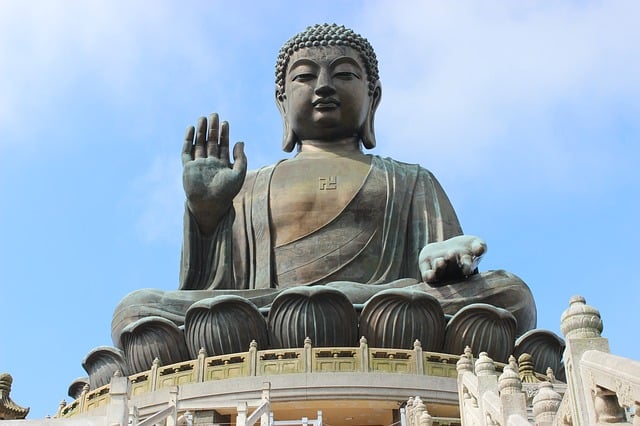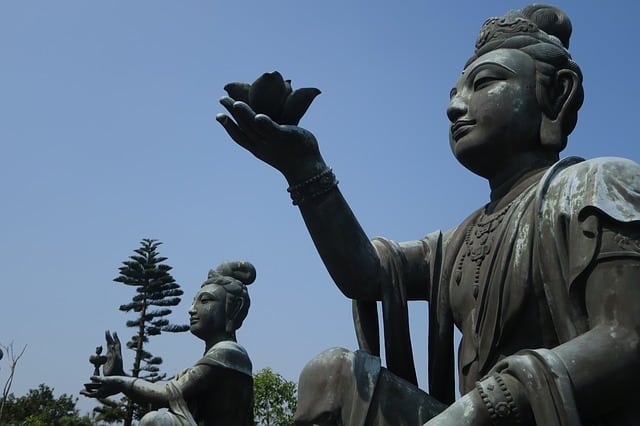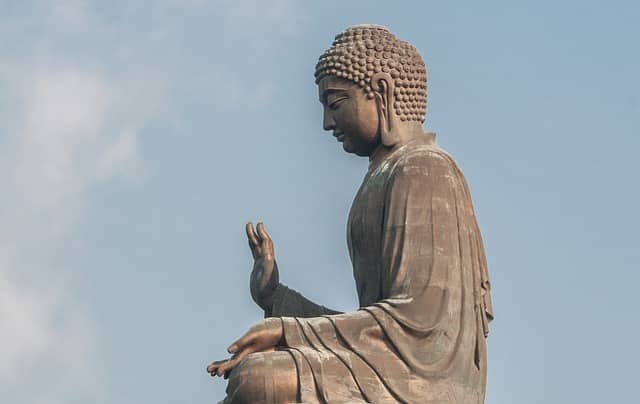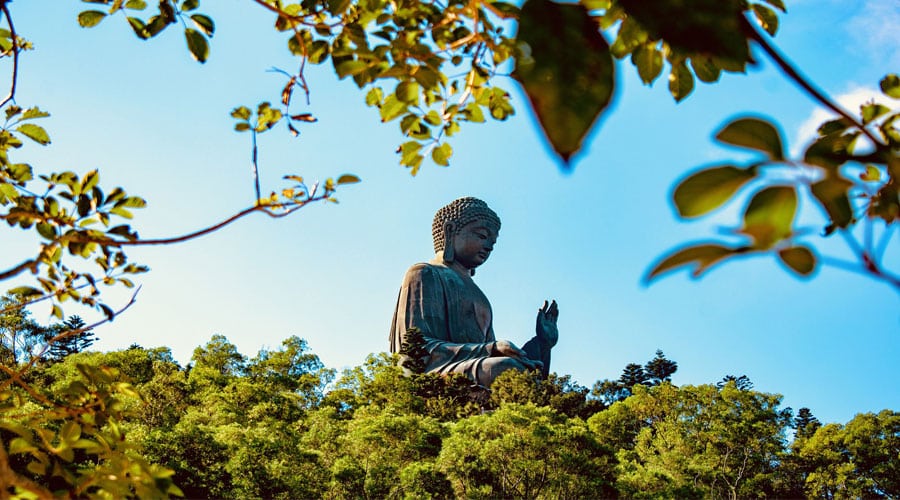Located on the mystical Lantau Island of Hong Kong, the Tian Tan Buddha, also widely known as the Big Buddha, stands as an emblem of serenity, spirituality, and sacred wisdom. This colossal, bronze statue of Buddha Shakyamuni is a major pull to tourists and pilgrims alike, making the Big Buddha an absolute must-visit in any Hong Kong travel itinerary.
Constructed in 1993, the Tian Tan Buddha’s awe-inspiring grandeur is only heightened by the jaw-dropping natural scenery that surrounds it. Perched atop the lush Ngong Ping Plateau, the statue’s unique location offers panoramic views of the South China Sea and the verdant mountains of Lantau Island—making the journey as rewarding as the destination itself.
The Big Buddha is not just a sightseeing spot; it’s also a spiritual center that attracts thousands of Buddhists from around the world. The statue’s name, ‘Tian Tan’, is a reference to the Temple of Heaven in Beijing, signifying the harmonious relationship between nature, man, and faith.

Visitors to the Tian Tan Buddha will find a series of 268 steps leading up to the statue—a climb that both challenges the body and soothes the mind. At the statue’s base, you’ll discover the Po Lin Monastery, a place of tranquil retreat that is renowned for its beautiful architecture, serene gardens, and delicious vegetarian cuisine. The Tian Tan Buddha experience promises a fascinating fusion of nature, culture, and spirituality. Make sure to add this majestic site to your Hong Kong sightseeing bucket list and also read this guide before visiting.
History of Tian Tan Buddha
Origin and Construction
The history of the Tian Tan Buddha began in 1970 when the idea of constructing a large Buddha statue was first conceptualized as a symbol of the harmonious relationship between man, nature, and religion. The actual construction began in 1990 and was completed in 1993, taking a total of three years.
The base design for this statue is modeled after the Temple of Heaven in Beijing. Tian Tan Buddha is among the five giant Buddha statues in China. It is on top of a three-platform altar enthroning a lotus. The statue was constructed out of 202 pieces of bronze and stands at a magnificent height of 34 meters (112 feet), weighing approximately 250 metric tons. The entire process was funded by donations from Buddhists all around the world. The design of the statue was also inspired by traditional depictions of Buddha Shakyamuni, symbolizing the harmonious relationship between man and nature, people and faith.
The Offering of the Six Devas
Hong Kong Big Buddha has six smaller bronze statues surrounding it. They are called The Offering of the Six Devas, and they have poses offering incense, flowers, lamps, fruit, music, and ointment to the Buddha. These devas are the symbols of the Six Perfections of wisdom, zeal, patience, morality, meditation, and generosity, which are all the means to reach enlightenment.

Significance in Buddhism
The Tian Tan Buddha is not just a monumental statue; it is also of substantial religious significance. The statue’s posture and gesture are symbolic of Buddha Shakyamuni’s enlightenment under the Bodhi tree. The right hand is raised, representing the removal of afflictions, while the left hand rests on the lap in a gesture of giving dhana.
The statue is surrounded by six small bronze statues known as “The Offering of the Six Devas,” symbolizing the Six Perfections of generosity, morality, patience, zeal, meditation, and wisdom—all necessary for enlightenment.
Situated nearby is the Po Lin Monastery, an important Buddhist sanctum, further enhancing the site’s religious significance. The monastery is home to many a monk and serves as a place of pilgrimage for Buddhists from around the world.

Cultural Impact
The Tian Tan Buddha has had a profound cultural impact since its inception. It has become a major tourist attraction in Hong Kong, drawing millions of visitors each year from around the globe. This influx of tourists has boosted the local economy significantly, making it a crucial component of Hong Kong’s tourism industry.
Apart from its economic impact, the statue has also played a significant role in promoting Buddhism in Hong Kong and elsewhere. Its construction has promoted the interest and understanding of Buddhist philosophy, contributing to cultural diversity.
The statue is not only an iconic symbol of Buddhism but also a repository of Buddhist teachings, making it a cultural and spiritual landmark that embodies peace, harmony, and the enlightened nature of Buddha.
The Tian Tan Buddha, with its grandeur and serenity, continues to inspire and fascinate, leaving an indelible mark on Hong Kong’s cultural, religious, and economic landscape.
Visiting Tian Tan Buddha
How to Reach
Reaching Tian Tan Buddha involves a scenic journey that’s almost as rewarding as the destination itself. Lantau Island, where the statue is located, is well-connected by both land and sea routes.
The most popular way to reach the Buddha statue is by the Ngong Ping 360 Cable Car. This 25-minute ride offers breathtaking panoramic views of the verdant mountains, the South China Sea, and the Hong Kong International Airport. If you’re starting from downtown Hong Kong, take the MTR to Tung Chung Station, from where the cable car terminal is just a short walk away.
Alternatively, you can also take a ferry from Central Pier to Mui Wo on Lantau Island, followed by bus number 2 to Ngong Ping Village. If you prefer road travel, direct buses (number 23) are available from Tung Chung Town Center.
[wpsm_colortable color=”main-color”]
| How to get to? | |
|---|---|
| By Taxi | The best way to reach there is to go to Chung Town Center and then by a taxi, Ngong Ping Cable Car, Bus No. 23 to reach the Tian Tan Buddha. |
| By Ferry | You can also take a ferry from Central to Mui Wo and then use New Lantao Bus No.2 to Ngong Ping. |
| From Tai O fishing village | If you plan to visit Tai O fishing village first, from there, you can take the Bus No. 21 that would take you to the Buddha in nearly 15 minutes. |
| Prices | |
| Entrance Fee | Visiting the outside of the Buddha and the monastery is free of charge. Keep in mind that you need to pay an admission fee to visit the halls under the Big Buddha. |
| Opening Hours | |
| Every Day | 8 – 18:30 |
[/wpsm_colortable]
Best Time to Visit
The Tian Tan Buddha can be visited all year round, but the best time to visit is from October to December when Hong Kong experiences mild and pleasant weather. These cooler, clear days offer the best views from the Buddha’s platform.
The site tends to get crowded during Buddha’s birthday (usually in May) and other Buddhist festivals, so if you prefer a quieter experience, it’s best to avoid these periods.
Tips for Visiting
Visiting Tian Tan Buddha is an incredible experience, and with a little planning, you can make the most of your visit. Here are some tips to ensure a smooth and enjoyable journey:
- Dress Appropriately: As a revered religious site, modest dress is recommended when visiting the Tian Tan Buddha and Po Lin Monastery. Avoid wearing revealing clothing. Hats and umbrellas can be useful to protect against the sun.
- Start Early: The site can get quite crowded, especially during weekends and holidays. Starting your day early can help you avoid the largest crowds and enjoy a more peaceful visit.
- Pack a Snack: While there are eateries in Ngong Ping Village, options could be limited. You may want to bring your own snacks or lunch, especially if you have special dietary needs. Don’t forget to carry a bottle of water, too!
- Comfortable Footwear: Remember, there are 268 steps to climb to reach the statue. Wear comfortable shoes suitable for walking and climbing.
- Check the Weather: The panoramic views from the Buddha’s platform are best enjoyed on clear days. Check the weather forecast before you leave.
- Don’t Rush: Besides the Buddha statue itself, there are other attractions to explore, including the Po Lin Monastery and Wisdom Path. Take your time to soak in the serene environment and explore the area.
- Respect the Customs: Remember to respect the customs and traditions of the site. Maintain silence in the monastery and avoid inappropriate behavior.
- Plan Ahead: Last but not least, plan your visit ahead. Check the latest information about opening hours, ticket prices, and transportation options. The Ngong Ping 360 Cable Car, for instance, occasionally closes for maintenance, and alternative transportation arrangements would need to be made.
Nearby Attractions
While visiting the Tian Tan Buddha, don’t miss out on the other fascinating attractions that Lantau Island offers. Here are a few you should add to your itinerary:
Ngong Ping 360 Cable Car
Your journey to the Tian Tan Buddha begins with a ride on the Ngong Ping 360 Cable Car. This 5.7 km bi-cable ropeway is one of the longest in Asia, offering mesmerizing views of the South China Sea, the lush green mountains of Lantau Island, and the Hong Kong International Airport. The 25-minute ride takes you from Tung Chung, across Tung Chung Bay, to land at Ngong Ping Plateau, where the Tian Tan Buddha is located. An unforgettable experience, the Ngong Ping 360 Cable Car ride is a must-do on your visit to Lantau Island.
Tai O Fishing Village
After you visit the Tian Tan Buddha, consider a trip to Tai O Fishing Village. A stark contrast to the bustle of Hong Kong, this tranquil village offers a glimpse into the local way of life that has remained largely unchanged for centuries. Known as the “Venice of Hong Kong,” Tai O is crisscrossed by waterways, with traditional stilt houses lining the banks. Here, you can sample delicious local seafood, take a boat ride to spot pink dolphins, and explore the vibrant local markets. This charming fishing village is a cultural gem that’s well worth a visit.
Lantau Peak
If you’re up for an adventure, trek to the summit of Lantau Peak—the second-highest peak in Hong Kong. The peak is best reached by a challenging but rewarding trail that starts from Ngong Ping Village. The hike takes about four hours to complete and offers stunning panoramic views of Lantau Island, the South China Sea, and on clear days, even Macau. The climb is particularly popular for its breathtaking sunrise views, making it a favorite amongst avid hikers and nature lovers.
FAQ
What is the Tian Tan Buddha?
The Tian Tan Buddha, also known as the Big Buddha, is a large bronze statue of Buddha Shakyamuni, located at Ngong Ping, Lantau Island, in Hong Kong.
What is the significance of the Tian Tan Buddha?
The Tian Tan Buddha symbolizes the harmonious relationship between man and nature, people and faith. It is a major center of Buddhism in Hong Kong.
What is the best time to visit the Tian Tan Buddha?
The best time to visit the Tian Tan Buddha is in the early morning when the site is less crowded and the weather is cooler.
What other attractions are near the Tian Tan Buddha?
Nearby attractions include the Po Lin Monastery, the Wisdom Path, and the Ngong Ping Village.
What is the entrance fee to visit the Tian Tan Buddha?
The entrance fee to visit the Tian Tan Buddha is HK$20 for adults, HK$10 for children aged 3-11, and free for children under 3. The fee includes access to the Buddha’s grounds, the exhibition hall, and the Wisdom Path. There is also an additional fee of HK$20 for adults and HK$10 for children to take the elevator to the top of the Buddha’s head. The entrance fee is payable at the ticket booth at the base of the Buddha. You can also buy tickets online in advance.
How many steps are there to reach the Tian Tan Buddha?
There are 268 steps to reach the Tian Tan Buddha. However, the site is also accessible via a small winding road for those unable to climb the steps.
How tall is the Tian Tan Buddha?
The Tian Tan Buddha is one of the largest seated Buddha statues in the world, standing at 34 meters (112 feet) high.
What is the Po Lin Monastery?
The Po Lin Monastery, located near the Tian Tan Buddha, is one of Hong Kong’s most important Buddhist sanctums and is known for its beautiful architecture, tranquil atmosphere, and vegetarian restaurant.
What is the Ngong Ping 360 Cable Car?
The Ngong Ping 360 Cable Car is a gondola lift on Lantau Island in Hong Kong, offering stunning aerial views of the surrounding area including the Tian Tan Buddha, Po Lin Monastery, and the South China Sea. It’s one of the most popular ways to reach the Big Buddha.































